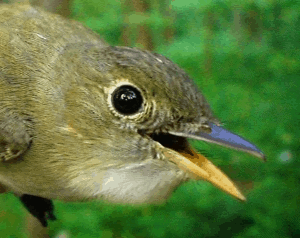
Migration activity was steady throughout the first half of the summary period and species diversity remained high, but numbers started to taper off after the 28th. It was fairly quiet after that apart from some shorebird activity and small numbers of migrant flycatchers, vireos, and a few lingering warblers.
May 21st turned out to be the busiest morning of the update period when 58 species were noted and 38 birds of twenty species were captured. Thirteen warbler species were tallied on the day along with moderate numbers of 6 flycatcher spp., 4 thrush spp. (including a few banded Gray-cheeks), and ones-and-twos of Black-billed Cuckoo, Red-eyed Vireo, Red-breasted Nuthatch, and Rose-breasted Grosbeak, among others. Steady rain on the 22nd reduced the coverage effort but there were still some birds in the area including 10 Ruddy Turnstones and 7 warbler species.
Forty-four species were recorded on May 23rd. Although just 4 warbler spp. were found, an Acadian Flycatcher was heard singing in the netting area and was later banded – the season’s first. A dramatic drop in temperature the next day made for a quiet morning apart from some chilly looking Tree and Barn Swallows feeding over the lake and a Northern Mockingbird observed at the tip. It was another cool morning on May 25th (5°C at dawn), but migrant numbers rebounded somewhat and 56 species were recorded on the day. Twelve warbler species were tallied, including a banded Connecticut Warbler, along with small numbers of Ruddy Turnstone, Sanderling, Dunlin, 4 swallow spp., and a range of other migrant songbirds in small numbers.
The 26th was fairly active and small numbers of late migrants were noted including 8 warbler spp., ones-and-twos of Traill’s, Yellow-bellied, and Least Flycatcher, and Swainson’s Thrush. Another Acadian Flycatcher was heard singing in the netting area. Similar activity on May 27th included 7 warbler spp., 6 Swainson’s Thrushes, and the season’s first Whimbrel. Steady rain and just 90 minutes of field coverage on the 28th produced 45 species.
A noticeable drop in activity was apparent after the 28th and, though a few migrants continued to arrive, the majority of birds recorded from the 29th – 31st were local nesters. Just two warbler species were observed on the 29th – Yellow Warbler and Common Yellowthroat – along with another Northern Mockingbird at the tip. The 30th and 31st were generally quite apart from some large flocks of Cedar Waxwings on census, including 65 birds on the 30th.
PIBO’s final spring summary will be posted on June 12th.
